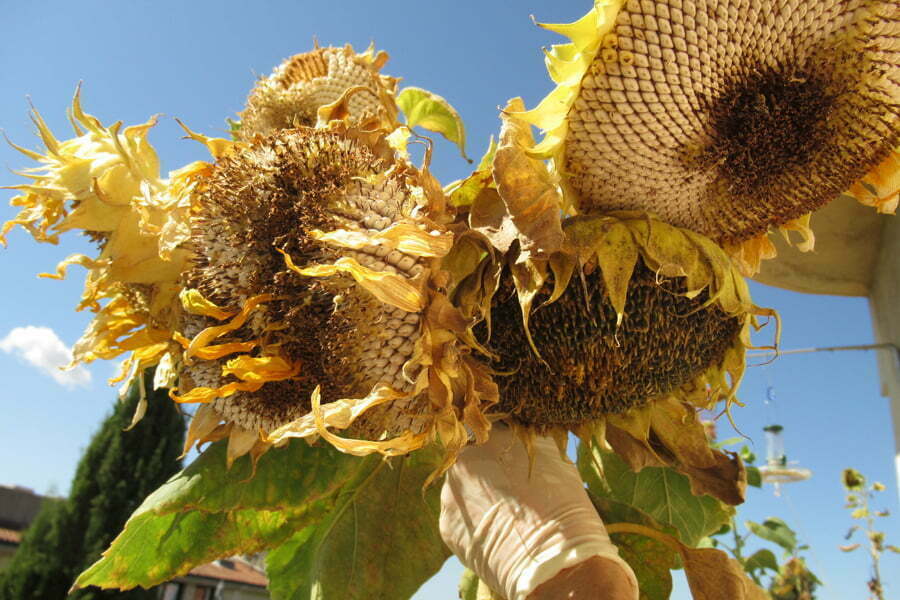May 6. It’s been over a year since we first went into Covid lockdown, and I am currently still obliged to obtain most of my entertainment from within my apartment in Aix.
Outside my window it is clearly springtime. The trees have leafed out, and the birds are very active.
The ideal viewing spot is on the floor, where I can look up through my window into the sky. Handily, morning exercises put me there.
Earlier this year I managed to attract local Mésanges bleues (Blue Tits—Parus caeruleus) to my feeder by attaching a couple of last year’s sunflower heads to the suet ball-feeder. But my avian guests changed with the coming of the vernal season.
In March, I began to see a pair of Mésanges charbonnières (Great tits—Parus major) come to dominate my balcony. (Maybe I have to find some better quality bird balls in the fall, because I noticed fewer visits this past winter than before.) I added a seed feeder, which is much preferred, and is visited repeatedly, especially in the early and late hours of daylight. The Mésanges bleues got intimidated by their larger cousins, and I saw them less.
Around the equinox, I spotted the first Martinets (Swifts—Apus apus) return from Africa, something that always lifts my spirits. They fly high in the sky, wheeling frenetically with their insect hunting. I understand these birds never alight on the ground, being helpless to launch themselves into flight except from lofty spots like roofs, where they usually make their nests.
At the same time, there came one splendid-looking male Chardonnert élegant (European goldfinch—Carduelis carduelis) Very soon, his mate (I’m guessing; the females look a lot like the males in this species) came too. These birds had very different feeding behavior to the Mésanges. The latter come, rather furtively, one at a time, snatch a seed and then scurry back to the safety of the Micoucoulier (Mediterranean hackberry—Celtis australis) in the parking lot adjacent to my apartment building.
The finches are much bolder, and though they fly away if they see me standing behind my window, (this is the advantage of my yoga-mat perspective, out of their peripheral vision) they are not intimidated by other birds who come whilst they are feeding. And they sit there gorging themselves for minutes at a time, flicking the seed detritus all over the balcony below.
Very soon others of the same species flocked to my balcony. I had to add seeds every day, as the finches were such sloppy eaters, half the seeds ending up on the floor. Several of them flocked to the feeder at once, occasionally displaying competitive behavior among themselves. Their riotous comportment certainly has deterred the Mésanges. The Charbonnières (which are the same size as the finches) wait to come until the coast is clear, but I rarely see the tinier Bleues any more.
I sweep up my balcony floor of the seeds and pieces dropped from masticating finches. The seeds that fall on the balcony balustrade are occasionally picked off by a Tourterelle turque (Mourning Dove—Streptopelia decaocto). The neighborhood also hosts their larger cousins, the Pigeon ramiers (columba palumbus), but they never come close.
My two orange tabbies, Pumpkin and Macauley, naturally are enchanted by the animation above. I chicken-wired off the part of my balcony directly below the feeders to discourage any feline interference (and to prevent anyone leaping off in a burst of untoward enthusiasm). The two cats are pretty chill—they make typical snickering noises, but so far seem to understand the birds are out of reach.
A consequence (Nature’s efficiency) of all that seed-dropping is a raft of seedlings that have sprouted in my balcony flower pots. I shall replant them in larger pots and hope for big sunflowers to in turn entice next winter’s avian friends.

PS: I’ve since installed a plastic dish to the bottom of the seed feeder to catch the debris. The finches immediately took advantage— now 3 or more can crowd around on the swaying platter to feed.

PPS: August 6—I’ve harvested the first crop of sunflowers, which came out both black and white-seeded. The birds had already discovered them, and picked away at some. I’m going to hide away these flowers from them so they can rediscover the bounty this winter, when there won’t be as bountiful a food source as now.

